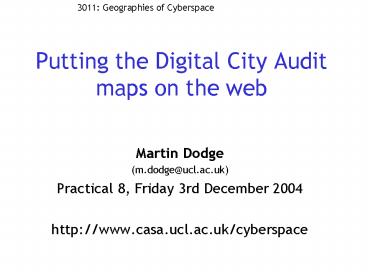Putting the Digital City Audit maps on the web PowerPoint PPT Presentation
Title: Putting the Digital City Audit maps on the web
1
Putting the Digital City Audit maps on the web
3011 Geographies of Cyberspace
- Martin Dodge
- (m.dodge_at_ucl.ac.uk)
- Practical 8, Friday 3rd December 2004
- http//www.casa.ucl.ac.uk/cyberspace
2
Aims of this practical
- working in your group you need to make a high
impact website of the results of the Digital City
Audit project - the actual design of the website is up to you
- you need to decide which one in the group will
use their account for the website
3
Saving your map for the Web
- I assume you made your map in Powerpoint the
other week - (if you have not done so, finish off the symbol
mapping now) - firstly, you need to make graphic files of your
map and the legend key that you can use on a web
page - the best way to do this is using a screen-grab
and then using Photoshop - In Powerpoint display the map in Slide Show mode
so it fills the whole screen. to do this go Slide
Show -gt View Show. Then use the PrtScn (Print
Screen) key, top right of keyboard, to grab the
screen - start Photoshop and then go File -gt From
Clipboard
4
- your map should now be in Photoshop
- you might want to crop or re-size the map image
as necessary (see notes from earlier practical) - now save the map image into the html.pub
directory. remember to set for format for the
file to PNG - now go back to Powerpoint and repeat the process
for the legend key - you now have the key graphics needed for your DCA
website. quit Powerpoint and Photoshop and start
up Dreamweaver for the web design - open a new page in Dreamweaver and save this as
DigitalCityMap.html (or similar) in the
html.pub directory
5
Website design content
- you have full responsibility for the design (the
look) and also the content of the site - in Dreamweaver place in the images you just
created of the map and legend on the blank page - remember rules of good design (KISS). choose a
good sized font. do you want to use coloured
fonts, background colours - add a title to the page, your names / emails,
date of survey, outline the aims of the project?
perhaps a paragraph or two describing the overall
field work experience and the area you surveyed.
any surprises in what you found - you might want to make a nice table giving some
facts and figures on what you found (4 ATM, 7
fixed cameras, etc)
6
- use the power of the Web to link to outside
information resources - you could link into other mapping projects (e.g.
CCTV camera maps or mobile phone antenna one) - links to site for further information (e.g.
congestion charging, BT phone boxes, etc etc) - use tables (visible or invisible) to layout the
page - are there any pictures or photos or figures you
can use to make the page look interesting. use
Google image search for example to find a picture
of a camera or a ATM - if you are dividing your map into smaller tiles
you might want separate web pages which are
linked together by hyperlinked arrows (like the
Newbridge disability access project)
7
Disability access mappingwww.may.ie/staff/rkitchi
n/newbridge.htm
a good example of detailed mapping on the
web check out the key that they use and
clickable links to photos they cut the map into
tiles, linked by arrows
8
Putting hotspots on the map
- In Dreamweaver, you can define hotspots on the
map so that when people click on them, it opens a
window with a picture, text description or
another web page - check out the http//www.spotthecam.nl as an
example - to make hotspots you select the image and then
use the Map tools
9
- you define hotspots around a feature on the
image using either the rectangles, circles or
polygon tool - then fill in the details on the Link and in the
Target box put new if you want it to open a new
a window
10
Spot the Camin Amsterdamclickable index map
linked to photos
www.spotthecam.nl
11
Making your webpage visible
- preview your web page now to see how it is
displayed in a browser (File -gt Preview in
Browser) - test that any hotspots are working
- when you are happy with the page design, save it
again (in html.pub) - just like for previous web pages, you now need to
run a program to make DigitalCityMap.html
visible on the web - go to Start button -gt Programs -gt Internet
Software -gt Publish Web Pages - (remember to type in your username and password
carefully)
12
- your new DCA web page should now be online
- open the page in Netscape, it will be at
- http//www.homepages.ucl.ac.uk/xxxxxxx/DigitalCit
yMap.html - (where xxxxxxx is your username)
- are you happy with the result. check the
hyperlinks work - how could you improve it?
- email martin the URL of the page

